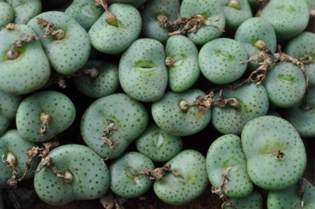Conophytum wettsteinii
Conophytum wettsteinii (A.Berger) N.E.Br.
Family: Aizoaceae
Common names: cone plant, dumplings, button plants (Eng.); knopies (buttons), toontjies (little toes), waterblasies (water blisters), ogies (small eyes) (Afr.)
Introduction
Conophytum wettsteinii are highly collectable, easy to grow, dwarf-cushioned succulents that produce attractive pink flowers in autumn.

Description
Description
Species in the genus Conophytum are dwarf-cushioned or single-bodied succulents of the vygie or ice-plant family, Aizoaceae. The genus is distinguished by the clusters of conically united leaves and petals which are fused into a basal tube (Smith et al . 1998). Conophytum wettsteinii has a broad top (20-25mm wide) and narrowed base. Individual plants seem circular from above, with fissures up to 4mm long. The plant has a green to blue-green colour with a spotted, smooth epidermis which may appear glossy. This species flowers only in autumn, with scentless flowers opening during the day. Flowers are short and wide, ranging in colour from magenta to pale pink or rarely white (Hammer 2002).
Conservation Status
Status
Although many Conophytum species are regarded as threatened, C. wettsteinii is listed as Least Concern (LC), with a stable population (Burgoyne 2006).
Distribution and habitat
Distribution description
Conophytum wettsteinii occurs in the eastern Richtersveld to around Steinkopf. Recently another population was found north of Umdaus (Hammer 2002).
Derivation of name and historical aspects
History
and historical factsThe generic name is derived from the Latin conus, meaning cone, and the Greek phytum, meaning plant, in reference to the cone-shaped fused leaves of many of the species in this genus (Smith et al . 1998). Conophytum consists of 106 species, categorised into 16 sections. Conophytum wettsteinii is the type species for sect. Wettsteinia, one of the larger sections with 17 species. The species is named after the Viennese phylogenist Richard von Wettstein (Hammer 2002).
Ecology
Ecology
Due to the extreme environmental conditions in which Conophytum species occur, the plants go into dormancy during the hot, dry summer months. The leaves die and dry out, creating sheaths protecting the following season's growth. In autumn, C. wettsteinii comes out of dormancy and produces a flower which persists until mid-winter. The leaves then continue to grow during the rainy winter months, and the plants return into dormancy with the approach of the dry hot summer.
Many Conophytum species are associated with gravel patches, e.g. quartz fields, which occur from the Knersvlakte northwards to the Richtersveld and Warmbad region. Conophytum wettsteinii is known from granitic patches around Steinkopf, forming large cushions and often growing in moss (Hammer 2002). The population north of Umdaus, however, was found in a quartz field, occupying a different geology, although similar habitat to the other known population of C. wettsteinii.
A range of flowering times exist in Conophytum from morning, late afternoon, early evening to night. Conophytum wettsteinii flowers during the day and has recently been shown to be predominately pollinated by small wasps (Juergens 2002).
The leaves of Conophytum wettsteinii are also interesting, with little translucent spots caused by tannin idioblasts (cells that differ from those around them in the same tissue). These idioblasts are thought to channel the influx of light into the leaf (Hammer & Hartmann 1990). The tannin idioblasts are also visible on the sheaths in the form of little brown dots.

Uses
Use
There are no recorded uses for this plant other than in horticulture.
Growing Conophytum wettsteinii
Grow
Conophytum wettsteinii is one of the hardiest species in the genus, and is rewarding for beginner and expert growers alike. Conophytum species are easily propagated from seed and cuttings and need well-drained mixed soil, with very little organic matter. Species flower in autumn to early winter (March to May) and actively grow during the winter months. In the hot summer months, the plants sheath and go into dormancy and should be kept dry. Although they are able to grow in full sun during their active period, they should be kept protected in shade during the hot summer months (Harrower 2003).
References
- Burgoyne, P.M. 2006. Conophytum wettsteinii (A.Berger) N.E.Br. National Assessment: Red List of South African Plants version 2013.1. Accessed on 2014/04/23.
- Hammer, S. 1993. The genus Conophytum : a Conograph . Succulent Plant Publications, Pretoria.
- Hammer, S. 2002. Dumpling and His Wife: New View of the Genus Conophytum (ed.). EAE Creative Colour, Norwich
- Hammer, S. & Hartmann, H. 1990. Shedding light on windows in Conophytum. Cactus and Succulent Society of America 62: 35-42.
- Harrower, A. 2003. Conophytum truncatum [Online]. PlantzAfrica, available at www.plantzafrica.com . Accessed on 2014/04/23.
- Juergens, A. 2002. Floral scent compounds in Conophytum species: chemical composition and its relevance to taxonomy and pollination biology. In S. Hammer (ed.), Dumpling and His Wife: New View of the Genus Conophytum. EAE Creative Colour, Norwich.
- Smith, G.F., Chesselet, P., Van Jaarsveld, E.J., Hartmann, H., Hammer, S., Van Wyk, B-E., Burgoyne, P., Klak, C. & Kurzweil, H. 1998. Mesembs of the World . Briza, Pretoria.
Credits
Aarifah Jakoet & Robyn Powell
Compton Herbarium
May 2014
Plant Attributes:
Plant Type: Succulent
SA Distribution: Northern Cape
Soil type: Sandy
Flowering season: Autumn
PH: Acid, Neutral
Flower colour: Pink
Aspect: Full Sun, Morning Sun (Semi Shade), Afternoon Sun (Semi Shade)
Gardening skill: Easy
Special Features:
Horticultural zones







Rate this article
Article well written and informative
Rate this plant
Is this an interesting plant?
Login to add your Comment
Back to topNot registered yet? Click here to register.